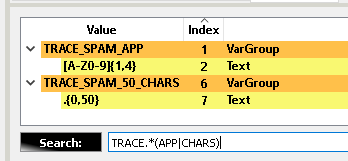Filters view
When you work with a complex regex expression, it is quite complex to find an important part of it to change some parameters.
E.g. the default regex, which is used in one of the projects where this plugin is used consists of 1831 characters. Try to find and change something in such a big string! It is a quite complex task.
To keep things easier, the “filters view” was introduced within the plugin. It does the following thing.
How to enter the “Filters view”?
Currently, entering the filters view is not so transparent. Thus, here is a gif animation, which represents how exactly to open it:

In future releases, we will think of how to make it more transparent for the user to enter it. We promise ))
How does it work?
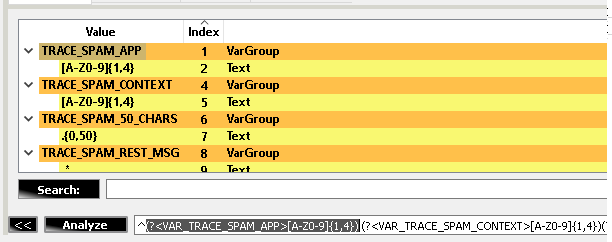
As you see above, each “VAR_TRACE_SPAM_APP” regex name is turned into a separate item in the tree view. It allows to build “regex with parameters” and easily exchange the content of your filter:

Change in a tree view is reflected in a final regex.
Also, selection within a tree view selects the corresponding part in the main regex input field:

If needed it is possible to switch from visualization of “Variables ONLY” to visualization of the whole regex:
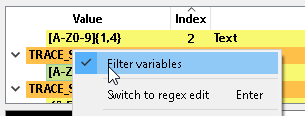
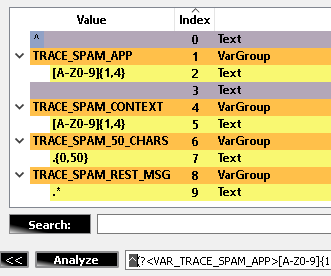
Note!
Plugin implementation allows you to search within the variables. The search mechanism is based on the regex, thus you can apply some non-trivial search logic:
This functionality is quite useful when you’ve formed a regex combination, which consists of several thousand characters and includes dozens of variables.
Note!
Be aware, that used implementation of the regex engine supports groups with name size of not more than 32 characters. If you’ll use more characters in the name - the engine will interpret the regex as an invalid one.
Note!
Another small piece of interesting information.
To parse the regex and fill in the “filters view” ( the view which works with the variables - I guess you see those yellow-orange screenshots on this page ) it is not enough to use Qt’s QRegularExpression class. Qt API does not provide information about the hierarchy of the groups.
To reach the goal, we’ve used the antlr4 parsers generator - https://github.com/antlr/antlr4
And the PCRE grammar, provided by the following repo - https://github.com/bkiers/pcre-parser
We’ve modified the above-mentioned grammar to allow faster parsing - https://github.com/svlad-90/DLT-Message-Analyzer/blob/master/thirdparty/pcre-parser/src/main/antlr4/nl/bigo/pcreparser/PCRE.g4
The call to the antlr generator is automated and is part of the CMake build.
Auto-completion
The plugin’s implementation supports auto-complete functionality for the “filters view”. All found regex captures are cached and used to help the user to go from the general to the specific queries. Auto-completion functionality works for all “VarGroup->Text” parts of the filters view’s tree. The restriction is that the target var group should have 1 single text child node. Otherwise, auto-completion will not be applied.
How does it work?
Imagine that you have a bunch of the system journal messages:

You can use the following regex to build the “filters view”:
^SYS JOUR [\d]+/[\d]+/[\d]+ [\d]+:[\d]+:[\d]+.[\d]+ (?<VAR_APPLICATION>[\w]+)([[\d]+])?: (?<VAR_MESSAGE_TYPE>[\w\d_-]+): (?<VAR_MESSAGE>.*)
The result “filters view” will look like this:
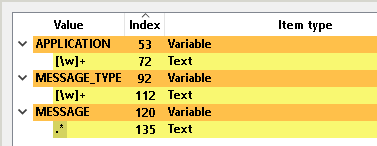
Click “Analyze” and perform the search:

You can either wait until the search is finished, or not. The auto-completion will be based on the currently available pre-cached data. It will work even if the completion data is not full yet. Of course, then the result will be limited to the available data.
Do a double click on the “Text” node within any of “APPLICATION”, “MESSAGE_TYPE”, “MESSAGE” variables. You will see the completion list view:
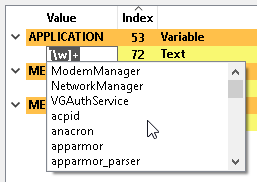
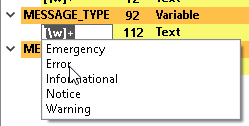
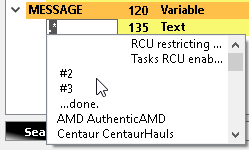
You can type in the characters to filter out specific suggestions:

| As we work with regexes, you might want to select more than one autocomplete value. In this case, once the first element is selected, enter the pipe ( “ | ” ) to search again without discarding the previous input: |
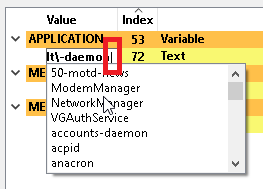
You can repeat this trick with a pipe multiple times.
Auto-completion supports different kinds of settings, which can be changed by the user:

- Case sensitive - whether suggestions filtering is case sensitive or not
- Max number of suggestions - the maximum number of suggestions, which is proposed to the user regarding its specific input
- Max characters in suggestion - the maximum number of characters in the suggestion. If the proposed string contains more characters, they will be cut off
- Pop-up width - width of the completion pop-up in pixels
- Search policy - policy used to filter out the suggestions. Either “starts with” or “contains”
AND operator
If needed, “color”, “variable”, “plantuml”, and any other supported regex name scripting options can be combined with the help of the “AND” operator. This operator is case insensitive, so you can use also “and”, “AnD”, etc:

